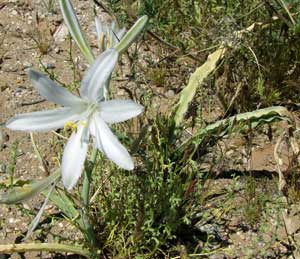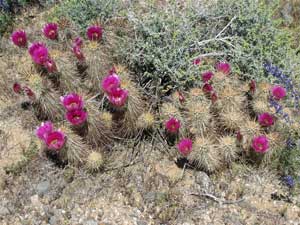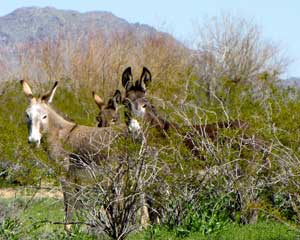BY JACKY DAVIS | ORIGINALLY PUBLISHED IN APRIL 2000
Spring Comes to the Harcuvars
A Desert Awakens
 Two years ago (1998) the Desert Awareness Committee happened on a video we liked so much we bought it for the collection at the Desert Foothills Library. Soon after, the Roses, who live in Prescott, showed their work at one of our classes. It’s a marvel, and we commend it to those wanting to learn more about the Sonoran Desert.
Two years ago (1998) the Desert Awareness Committee happened on a video we liked so much we bought it for the collection at the Desert Foothills Library. Soon after, the Roses, who live in Prescott, showed their work at one of our classes. It’s a marvel, and we commend it to those wanting to learn more about the Sonoran Desert.
 The Harcuvar Mountains are due west of Wickenburg; from the south they are reached from US 60. Though not in the Arizona Uplands subdivision of the Sonoran Desert to which Cave Creek and Carefree and much of the Tonto National
Forest belong, the Harcuvar Mountains in their highest regions have much in common with this area. Footage in the Roses’ video looks a lot like these foothills, and all the wildlife they observed can be found right here.
The Harcuvar Mountains are due west of Wickenburg; from the south they are reached from US 60. Though not in the Arizona Uplands subdivision of the Sonoran Desert to which Cave Creek and Carefree and much of the Tonto National
Forest belong, the Harcuvar Mountains in their highest regions have much in common with this area. Footage in the Roses’ video looks a lot like these foothills, and all the wildlife they observed can be found right here.
At the lower reaches, particularly from the south and west, the mountains look desolate, dry, and rocky, and they are. But higher up and along the many drainages, the terrain and the vegetation begin to look remarkably familiar. Few roads and people encroach on the habitat the Roses studied, so no doubt they were able to catch frequent glimpses of animals we now observe very rarely. But in the spring, after decent rain, they saw what we see, the same trees, shrubs and wildflowers, the same new life. In the film they mention specific washes where they spent the most time, though you might need a topographical map to find them.
 Returning to the Harcuvars hundreds of times over five successive springs, the Roses filmed and photographed extensively. (With the video they have included a list of 106 species, in the order in which they appear.) From February to June during these years, filming both night and day, they recorded all they saw: a progression of blooms, the sunning, fighting, and courting activities of lizards, and snakes’ responses to temperature variations, among other things. (They observed, for example, that snakes will lie in full sun at 75º, prefer partial shade from 75º to 85º, seek full shade between 85º and 95º, and disappear underground when the temperature is above 95º.) The quality of the work is amazing: beautiful footage of species after species, from butterflies to badgers, from Tidy-tips to Tarantula Hawks, lovingly filmed by two people intimately acquainted with them.
Returning to the Harcuvars hundreds of times over five successive springs, the Roses filmed and photographed extensively. (With the video they have included a list of 106 species, in the order in which they appear.) From February to June during these years, filming both night and day, they recorded all they saw: a progression of blooms, the sunning, fighting, and courting activities of lizards, and snakes’ responses to temperature variations, among other things. (They observed, for example, that snakes will lie in full sun at 75º, prefer partial shade from 75º to 85º, seek full shade between 85º and 95º, and disappear underground when the temperature is above 95º.) The quality of the work is amazing: beautiful footage of species after species, from butterflies to badgers, from Tidy-tips to Tarantula Hawks, lovingly filmed by two people intimately acquainted with them.
The Roses emphasize that they aren’t professional filmmakers; nor are they trained in natural science. They went to the Harcuvars to escape the winter cold and to learn more about life there. Soon they wanted to share what they had learned, particularly, as Ralph Rose has said, if it can help others become less afraid of an environment they know can be intimidating. Back in Prescott, Ralph learned about production at Prescott College. The video has been widely reviewed and praised.
 The narration, written and read by Ralph Rose and carefully edited, gets the viewer’s attention immediately. Some critics objected to his voice as too weak, but I liked it. It’s so personal, his signature, the voice of one who is so fascinated by direct observation of the world around him he wants to tell
about it himself. There’s no deceptive camera work here, either. This film is solid and honest, and would be, I imagine, very impressive to anyone who has ever operated a video camera. He is often amused by the animals and describes his subjects with refreshing originality: a Gila monster is “rather surly,” and a desert tortoise that declines to emerge from his shell is simply “refusing to be interviewed.” Snakes, he helpfully points out, do not herd well, especially when it’s necessary to drive one from under a car where it went to find shade.
The narration, written and read by Ralph Rose and carefully edited, gets the viewer’s attention immediately. Some critics objected to his voice as too weak, but I liked it. It’s so personal, his signature, the voice of one who is so fascinated by direct observation of the world around him he wants to tell
about it himself. There’s no deceptive camera work here, either. This film is solid and honest, and would be, I imagine, very impressive to anyone who has ever operated a video camera. He is often amused by the animals and describes his subjects with refreshing originality: a Gila monster is “rather surly,” and a desert tortoise that declines to emerge from his shell is simply “refusing to be interviewed.” Snakes, he helpfully points out, do not herd well, especially when it’s necessary to drive one from under a car where it went to find shade.
In his introduction, Ralph Rose says he and Boonmee (she grew up on a farm in Thailand) simply fell in love with the desert and wanted to learn what it had to teach. During the time they spent in the Harcuvars, they usually tried to let animals initiate any contact. They sensed, he says, “In doing so they are taking a great risk.” In one scene a snake sets its course right between Boonmee’s feet as she squats on the ground. She is clearly delighted, and the snake is positively nonchalant. In another memorable shot, though, Boonmee reaches out her hand and strokes the head of a hummingbird perched in a tree. Remarkably, the hummingbird, known to be feisty and highly territorial, sits still for this. Here in Cave Creek, Boonmee smiled just as she does in the film but rarely spoke. The animals in the Harcuvars appear to have been as charmed as we were.
The Roses close their video with some words of caution and a demonstration of how to get a stuck car out of a sandy wash. They advise visitors to carry water and appropriate tools, dress for the weather, and treat the desert with respect. Still the Roses advocate experiencing the desert firsthand if possible. “If you should have an opportunity to explore the desert, do so,” says Ralph Rose in closing. And if you do decide to head out, we recommend watching this video first. Watch it several times. (Ralph’s voice grows on you.)
Few people will want to return to the same place as often as the Roses, but as a guide to viewing the desert and recognizing what you will see there, Spring Comes to the Harcuvars: A Desert Awakens, is one the best things I’ve ever seen.
Photos by Dave Mills: (from top-bottom) Ajo Lily, Hedgehog Cactus, Wild Burros



